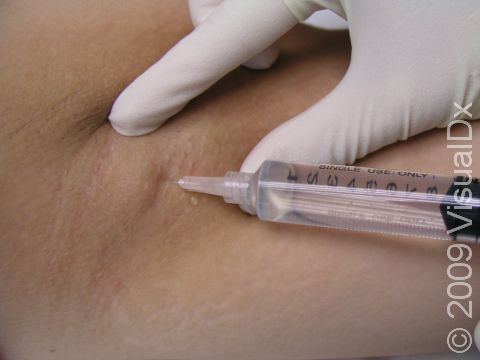Anesthesia For Dermatologic Surgery, Local
Injection of anesthesia is a commonly used method to numb a small area of skin undergoing a surgical procedure.
Surgical procedures require local, regional, or general anesthesia to minimize the pain and discomfort. The type of anesthesia used depends largely on the procedure itself and location of the body where it will be performed, as well as the physician’s and patient’s preference. Minor surgical procedures of the skin usually require only local anesthesia.
Who's At Risk?
The use of local anesthesia should allow a patient to undergo a minor surgical procedure with no pain while remaining fully conscious.
Signs & Symptoms
No preparation by the patient is necessary for the use of local anesthesia.
During the procedure, the skin in the area is cleaned with an alcohol wipe. A small needle attached to a syringe is inserted into the skin, and a numbing solution is injected around and within the area to be removed or treated. Patients will initially experience a brief stinging sensation related to the needle and the anesthetic being introduced. Within seconds, typically, the area becomes numb.
Self-Care Guidelines
Patients tolerate injection of a local anesthetic with minor to no distress. Once the skin is numb, the surgical procedure can be performed.
No aftercare is necessary following an uncomplicated injection of local anesthesia.
Treatments
- The topical application of a numbing cream covered by a dressing 1–2 hours prior to the procedure is an alternative to anesthetic injection in some cases.
- Some patients decline anesthesia and instead use techniques such as meditation, hypnotism, or distraction.
- Injection of saline or diphenhydramine can be used somewhat in place of anesthetic.
When to Seek Medical Care
Risks and side effects associated with local anesthesia depend, to a large extent, on the local anesthetic agent used, the technique, and the site of administration. It is a common and safe office procedure, but risks and side effects occurring at the site of injection may include the following:
- Infection with potential for abscess formation
- Bruising or blood clot formation
- Injury to nearby structures (eg, nerves, muscles)
- A reaction to the anesthetic agent, either in the immediate area of the anesthetic (local) or to the body in general (systemic)
Last modified on October 10th, 2022 at 3:26 pm

Not sure what to look for?
Try our new Rash and Skin Condition Finder
